By Krista Halling DVM DACVS and River
Biking with your dog can be one of the most joyful and enriching things you’ll ever do together. For you and your dog to get the most of that experience, there are some important considerations both for your bike and for your dog. Here’s a guide to biking with your dog, based largely on my experience dogpacking on my bike with my mini goldendoodle, River.
Bike Considerations
When biking with a dog, stability and control matter more than speed. You don’t need a custom rig—but some setups will make the riding easier. Look for:
- Flat-bar or touring bikes offer a more upright posture, letting you watch your dog and stabilize better during turns.
- Wide flat bars give you better control of the bike than do narrow bars or drop bars.
- Cargo bikes (such as Salsa Blackborow, Surly Big Dummy or Omnium bikes): these are great if your dog is much larger than 15kg (33 lb) or if you enjoy having room for a lot of gear. But keep in mind that they will also inherently be quite heavy, and trickier to fit in a car or to pack up for air travel.
- Rear racks give you space for a basket without compromising balance.
- Wider tires (2.0”+) help absorb vibration—better for your dog whether they’re riding or running.
- Low gearing is essential. Your dog, their food and their gear adds serious weight. Prioritize climbing gears over speed.
- Brake upgrade: A fully loaded setup (you + bike + trailer + gear + dog) is very heavy and thus takes more breaking power to stop efficiently. Consider upgrading your brakes and the diameter of your rotors, if you’re riding hilly terrain.
Compatibility considerations
If using a trailer, check compatibility with your axle (you may need an adapter) or your seat post. If using a basket, the basket shouldn’t be much longer than the rack, since having the basket with a dog in it cantilever past the back of the rack may cause bike handling issues and/or may cause the basket to crack since it’s not sufficiently supported.
Also check that the rack is rated for the load of your dog + basket, and mounted solidly. Also note that if your dog jumps into the basket, the load on the rack when your dog lands in it will be higher than your dog’s body weight (due to the physics of mass x acceleration). So best to have some wiggle room in terms of the maximum weight the rack can handle.
Safety note: With a full load (bike, gear, dog), your bike will feel less stable—especially at slow speed—and your braking distance will also increases dramatically. Practice your setup without your dog before hitting a trail together.
Also keep in mind that if your dog is in a bike basket, the taller (or more upright) the dog, the higher their centre of gravity. This means that your bike handling will be affected by your dog sitting up in the basket, especially if they also lean over to look at where you guys are headed.
For me this was initially a big issue when I was first leaning to Bikepacking with River. My bike was already too heavy with all my touring gear (yes, I brought the kitchen sink—ya never know when you’ll need it), and I was in my lowest gear trying to climb a steep hill (read, mountain) in Colorado. Since I was going so slowly, the bike had become pretty wobbly. And since the bike was wobbly and we were going so slowly, that’s when River decided to sit up and lean over the side to see why we were going so slowly. That was enough to bring my forward progress to a halt, and over we went. Fortunately, River was used to hopping out of the basket and clear of the bike, so she was fine.
Should Your Dog Run, Ride, or Both?
The first decision isn’t what trailer to buy. It’s what your dog is physically and mentally suited for.
Running beside a bike is a high-impact, high-stimulation activity. It’s not a default. It’s a demanding task that requires fitness, joint integrity, heat tolerance, and well-conditioned behavior. If your dog is young, healthy, high-energy, and already enjoys running, this may be an option—with thoughtful conditioning and awareness of the impact level and roughness of the surface they’re running on.
But not all dogs are built to run. Short-nosed breeds (also called brachycephalic breeds) are prone to overheating and have a harder time breathing, so be mindful of this if you’d like them to run beside your bike. And even those dogs who are keen runners may not want to do it every day, in every weather, or at your pace. That’s where riding options come in.
Bike Setups: Trailer vs Basket
Trailer
Trailers are a great option especially for medium and large dogs—or any dog that needs a break from running. They give your dog space to sit, lie down, or curl up while you continue moving.
Two-wheel trailers offer more stability, making them safer for dogs who shift around, brace, or move during the ride. They’re ideal for dogs who ride longer distances or who need more room to adjust. But they are trickier on single track or very technically terrain because the wheels may not be touching the ground at the same time, creating a very bumpy ride for your dog.
Single-wheel trailers track directly behind the bike and handle tight trails better, but they’re less stable and more affected by rider movement or terrain bounce. These require a confident dog and confident rider. Dogs need to stay centered to avoid tipping.
Veterinary Tips about Trailers:
- Trailers without suspension can transmit every bump and vibration to your dog’s spine, joints and brain. Generous floor padding, such as several layers of a closed-cell foam sleeping pad is essential.
- Trailers also are less well-ventilated than baskets, so your dog overheating is a huge consideration in warm temperatures, especially if it’s a humid day. Keep a close eye on any dog in a trailer even if the bike’s moving or there seems to be a breeze. I also recommend placing a digital thermometer in the trailer, so you can monitor the temperature and humidity at a glance, ideally from your smartphone.
Basket or Rear Crate
Baskets work best for dogs under 15kg (~35 lb). Rear-mounted baskets offer more bike stability than front baskets, especially when loaded with a moving animal. They also reduce your dog’s exposure to wind and blowing dirt and they don’t interfere with steering.
A well-secured, padded basket over a sturdy rear rack can create a cozy and responsive ride setup. With practice, many dogs learn to hop in and out on cue. Use a short tether attached to a body harness (never a collar), and keep leash slack minimal to prevent entanglement.
Dogs who feel safe in their basket will often treat it as a mobile den. Some even nap between stops. But don’t assume that stillness means comfort—especially early on. Watch for shifting, frequent position changes, or reluctance to re-enter. These are signs to slow down, change padding, or take a break.
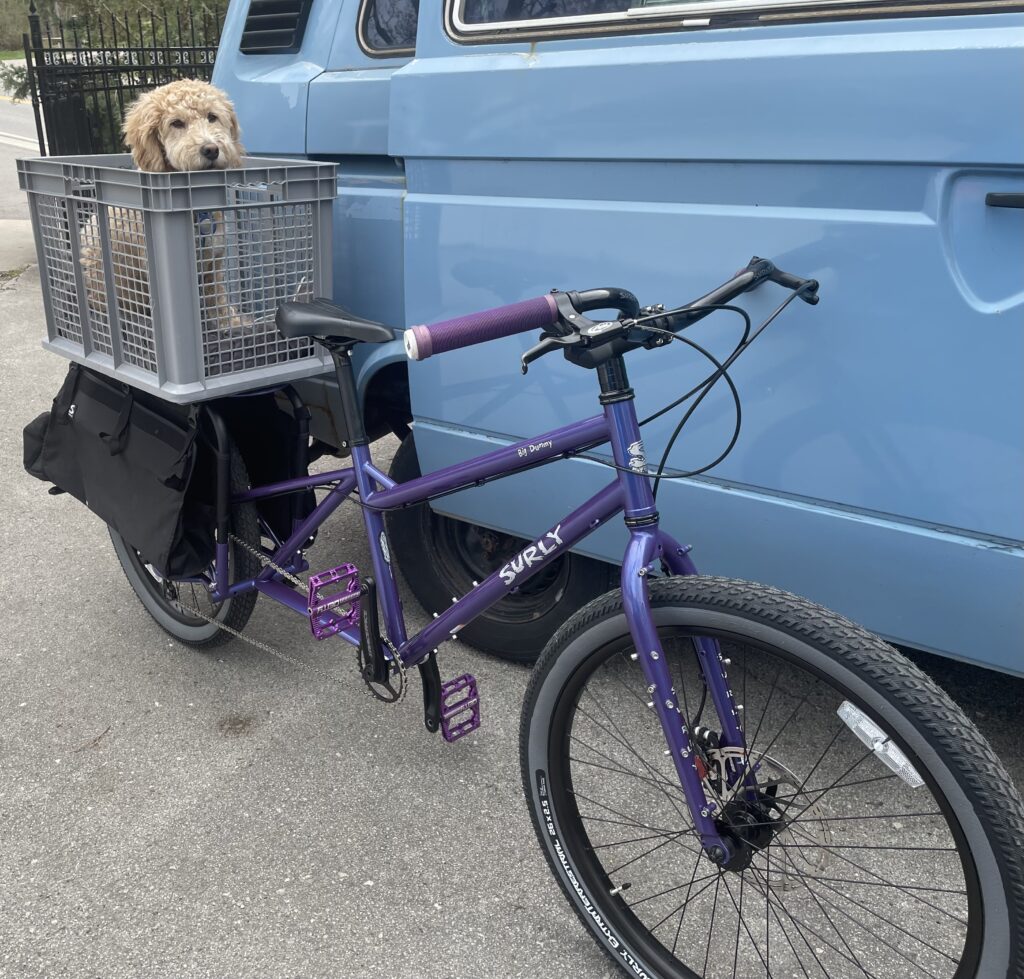
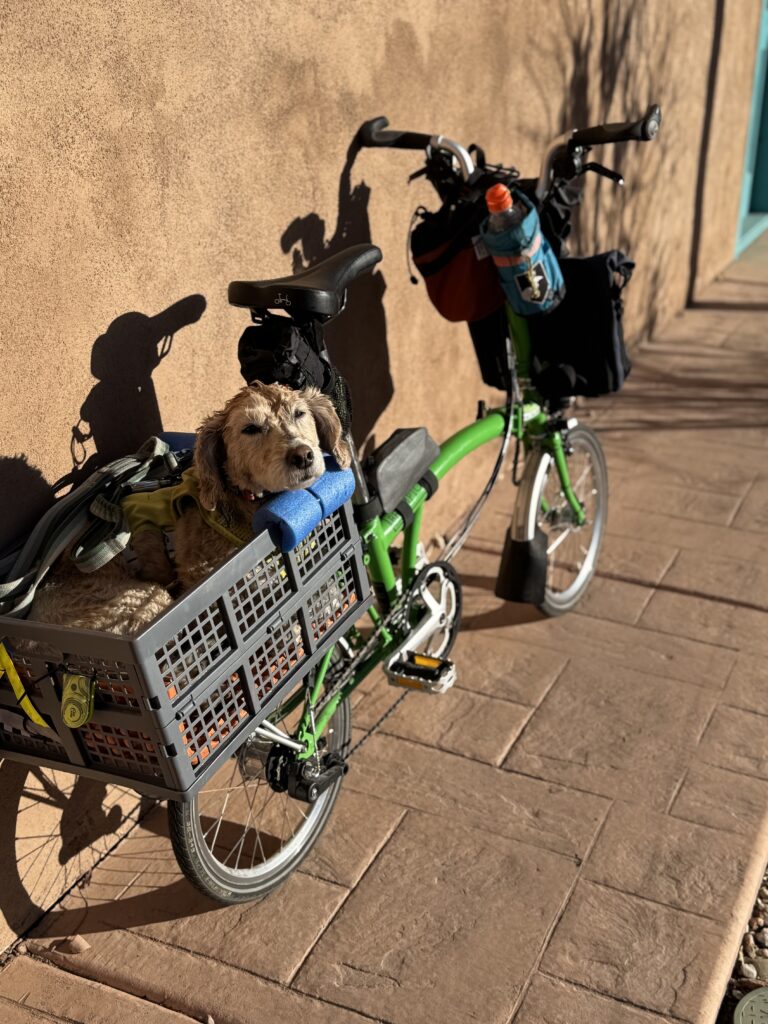
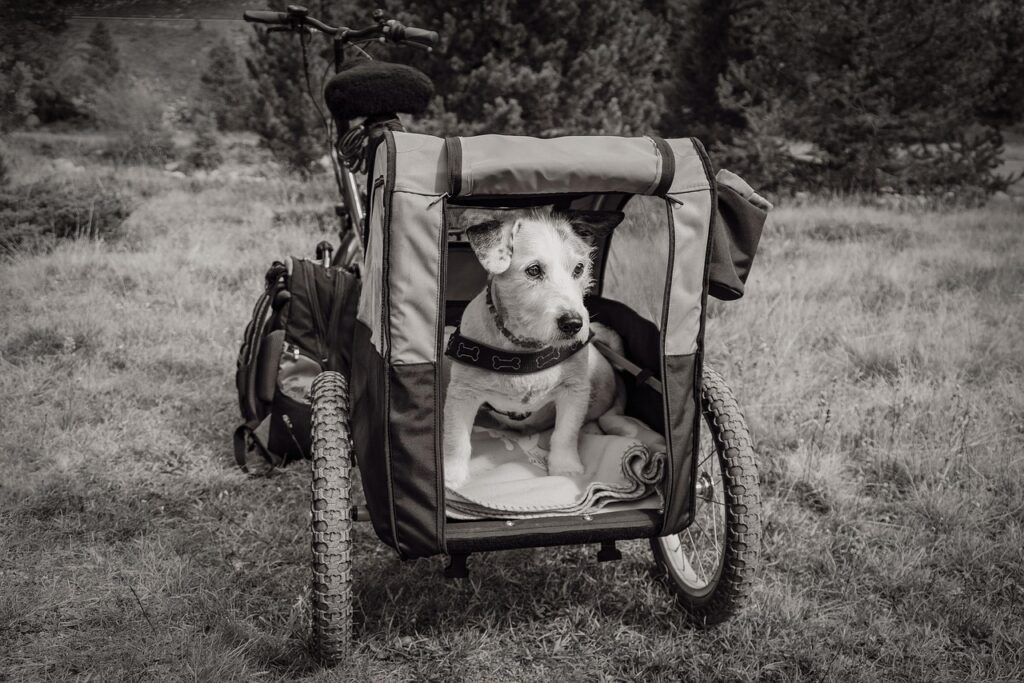
Training Your Dog to Ride (Basket or Trailer)
This is one of the most overlooked—and most crucial—parts of biking with your dog.
Dogs don’t naturally understand baskets or trailers. To them, it’s a moving box full of vibration and unfamiliar motion. Confidence takes time and consistency.
Training Plan for Basket or Trailer
1. Let them explore the basket or trailer at home without movement. Toss in treats and make it fun.
2. Feed meals inside the trailer or basket to build positive associations.
3. Practice stillness with your dog inside while clipped in with a harness tether.
4. Walk the trailer or carry the basket a few steps while praising calm behavior.
5. Go for a short, quiet ride—5–10 minutes max on smooth ground.
6. Build up slowly, giving praise and breaks. Let your dog decide when they’re ready to go longer.
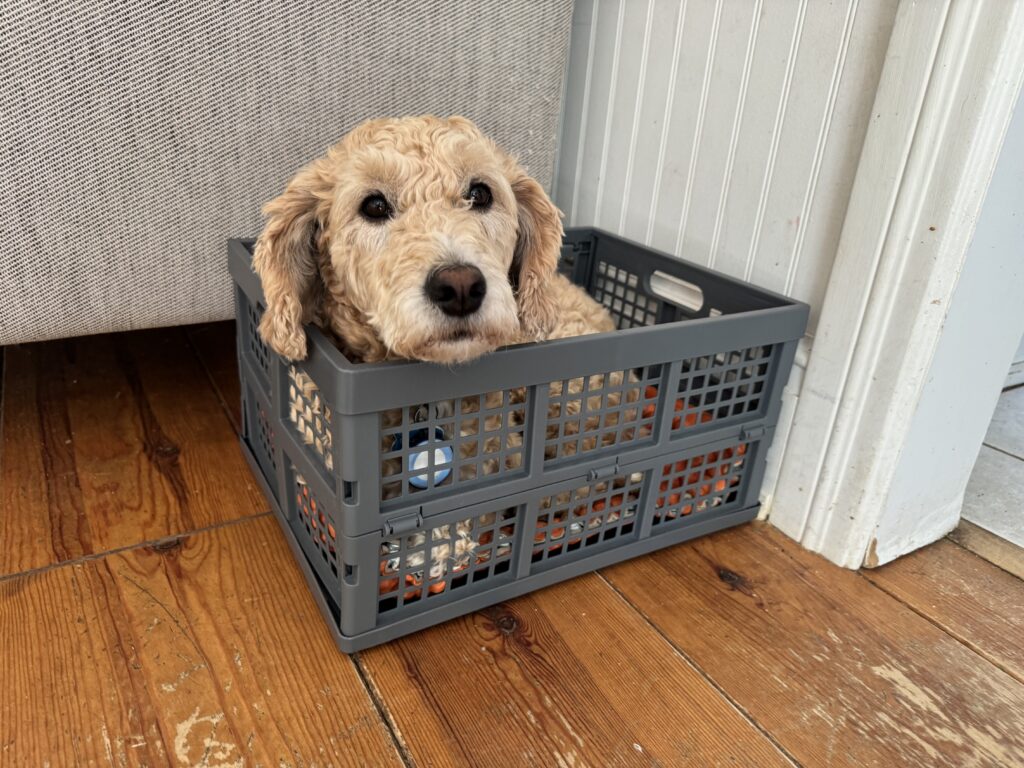
Your dog should feel like it’s their idea to get in. Not because they were told to—but because they’ve learned it’s safe.
Should you tether your dog to the basket? I can’t speak for trailers since I haven’t used one, but for bike baskets, it’s probably best not to tightly tether your dog to the basket. The issue is that if the bike crashes or tips over, your dog needs to be able to jump clear of the falling bike and not get tangled in a short leash or end up half-in, half-out of the basket or under the bike.
Running Beside the Bike: How to Do It Safely
If your dog is physically capable of running beside the bike, use a waist-worn bungee leash or bike-specific attachment that allows safe distance and shock absorption. Attach to a body harness—not the collar—and use a short enough length (around 6 feet) to keep your dog near the rear wheel but away from the front.
Teach your dog run on the inside of your bike (i.e. whatever side is away from road traffic). This sets you up and your dog up for a safer situation. Continue this practice even if you’re on traffic-free bike trails, so that it becomes their default side to run on.
Avoid pavement. Hot or abrasive surfaces can quickly damage paw pads. Forest roads, shaded trails, or packed gravel are best. Be mindful of heat: dogs can’t sweat, and their cooling ability is far less efficient than ours.
Watch for signs of fatigue: lagging behind, shortening stride, increased panting, head or tail carriage changes. Dogs don’t complain—but they do communicate.
Conditioning: Build Fitness Gradually
Whether your dog is running or riding, they need conditioning time.
Start with short outings and increase gradually. For runners, that may mean starting with just a few minutes beside the bike, adding distance week by week. For riders, it means building up their tolerance for vibration, duration, and heat.
Just like human athletes, dogs need recovery days. Overdoing it early can lead to soft tissue injuries or proprioceptive fatigue—when a dog’s body awareness decreases and they begin to stumble, misjudge terrain, or move hesitantly.
If your dog is hesitating to get in the trailer or basket the next day, pay attention. That’s often a sign of soreness or overload, not stubbornness.
Another important consideration is that fitness isn’t just about their ability to run. To reduce a dog’s risk of injury, it’s smart to do exercises that create balanced fitness by including these core fitness pillars: aerobic, proprioception, strength, balance and flexibility.
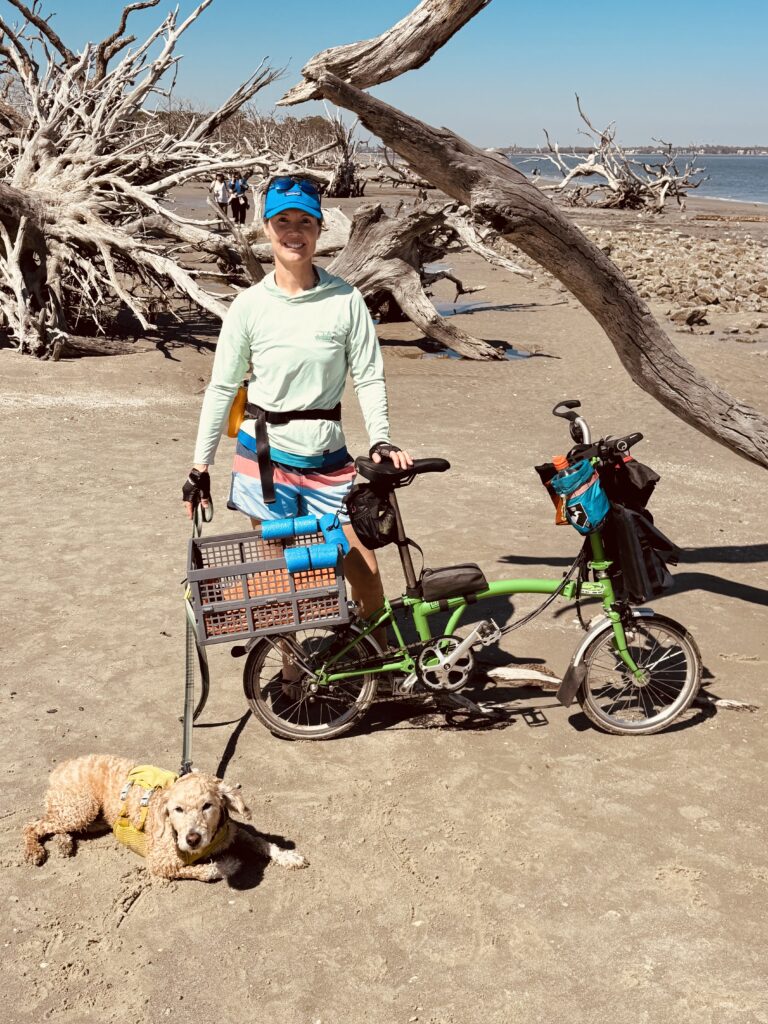
Managing Transitions and Movement During a Ride
One of the trickiest things to master is getting your dog safely in and out of a trailer or basket when stopping on the trail.
Dogs learn through patterns. With practice, many dogs will:
• Wait for a verbal cue or leash tension before jumping out
• Time their re-entry with a running hop when you stop
• Navigate transitions safely if the surface is clear and the basket or trailer is low enough
Rear-mounted baskets over a rack make this easier than handlebar baskets, which are higher and less stable for jumping. Never force these maneuvers; they must be taught slowly and positively.
Always double-check that the leash is not dangling near any moving parts. If you teach your dog to hop out of the trailer or basket, make sure the bike is fully stopped! There’s enough risk of joint or muscle injury from just a stationary jump—but if your bike is also moving forward when your dog jumps out, the forward momentum of their body will likely cause twisting upon landing and that puts your dog at high risk of an orthopedic injury.
Before River jumps out, I always make sure my bike is fully stopped. I try to have grass beside the bike for her to land on (as it’s much lower impact than pavement or a dirt road), and I verbally say “Wait…” to cue up her body and brain so it’s ready for the jump (an unexpected jump or fall from the bike can cause injury to your dog) and then I give the command “Jump!” once I’ve made sure the leash isn’t tangled and I’ve got hold of the end of the bungee section. Note: a bungee leash will only cushion your dog’s jump if the bungee section is located between your hand and the dog.
Managing Hydration and Heat
Dogs dehydrate easily, especially when moving, panting, or exposed to wind. Always offer water at breaks—don’t assume they’ll ask.
• Bring a dog water bottle or collapsible bowl
• Stop and offer water every 10-30 minutes depending on weather and exertion (they may not drink that often, but best to offer if frequently, so they have the choice of drinking some)
• Watch for signs of dehydration: thick saliva, dry nose, fatigue, or sunken eyes
• If riding in heat, consider cooling vests or bandanas, shaded stops, and limiting mid-day activity. We’ll do a separate article on cooling vests, but note that they largely only work if the relative air humidity is low, and they need to be kept wet. A dry cooling vest or a cooling vest placed on a very humid day might actually insulate your dog and worsen their overheating.

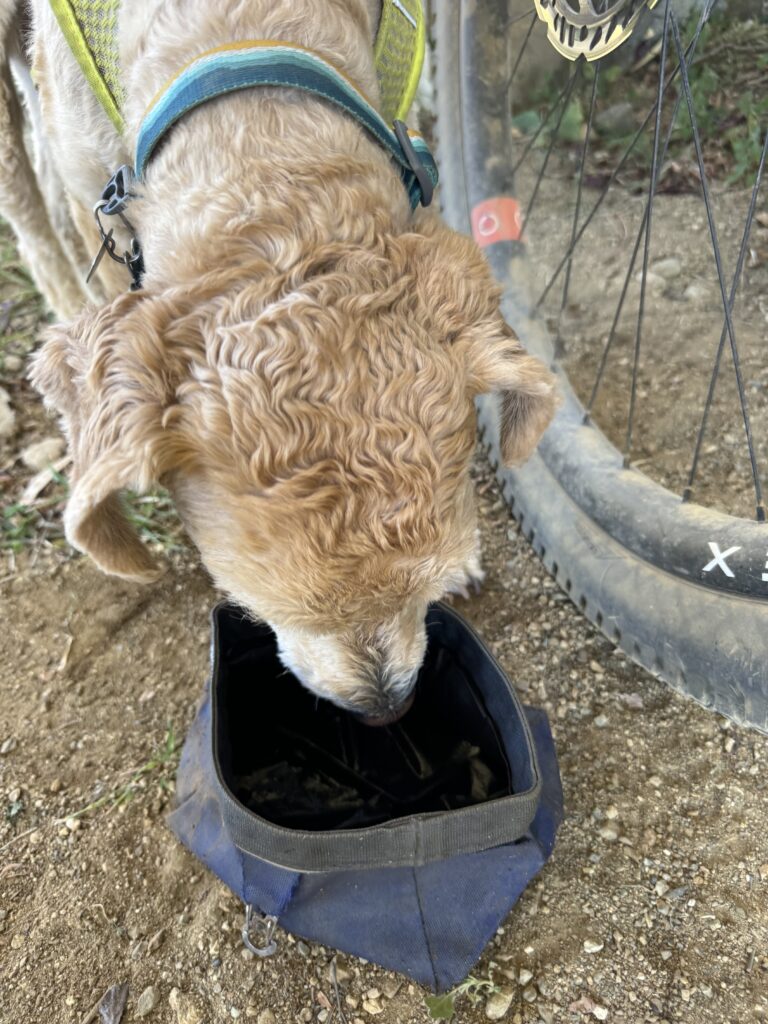
Dogs running alongside you might self-regulate by slowing down—but only if you let them. Dogs are notorious for continuing to exert themselves if they are having fun or if you keep going. So keep a close eye on your dog and if in doubt let them have a rest. Dogs riding in trailers need breaks too, especially in enclosed setups with limited airflow. (See my note about a digital thermometer.)
• Take sniff breaks. These aren’t just for bathroom use—they’re a mental reset that lowers cortisol and stabilizes behavior.
• Carry cooling gear like lightweight vests or bandanas in hot weather. Shade makes a huge difference. As does cool water immersion. Don’t immerse a hot dog in cold water—that causes their skin blood vessels to constrict, thereby keeping heat in!
Surface temperature matters and footpads can burn. If the ground is too hot for your hand, it’s too hot for paws. Dogs will lift their feet, dance in place, or avoid movement when it burns. That’s not pickiness—it’s pain.
Trail Nutrition
Running dogs burn 1.5 to 2 times their normal caloric needs. Even dogs riding in Baskets or trailers use energy maintaining balance, bracing, and processing sensory input. Plan your dog’s nutrition as carefully as your own.
• Feed small meals at least 1–2 hours before activity to prevent GI upset or bloating. Also wait 1-2 after exercise before feeding, to reduce risk of stomach bloat (GDV).
• Trail snacks (jerky, high-fat biscuits, cheese) keep energy up during long rides
• Transition foods slowly if buying new food mid-trip—mix with familiar kibble to avoid digestive issues
• Bring extras—running low on dog food mid-trip is not an option
Gear Essentials
Here’s what to bring—beyond the bike itself.
- Well-fitting body harness (Y-style preferred for comfort and range of motion)
- Leash with shock absorption (waist-worn or bike-mounted)
- Paw balm (Musher’s Secret or similar) for pre/post-ride protection
- Booties for rough terrain or hot surfaces (introduce gradually)
- Cooling gear for summer rides
- Eye protection (RexSpecs) for dogs riding exposed in wind/dust
- Generous padding for trailer or basket—minimizes impact and fatigue and stabilizes your dog
- Dog food and treats: store in odor-proof, waterproof bags
- Spare leash
- Poop bags
- First aid kit: vet wrap, tweezers, eye drops, antiseptic, extra bootie, soft muzzle
- Coat for rain or cool weather
- Multi-tool and spare parts (especially if pulling a trailer)
- Spare Brake pads (more wear = faster replacement)
Where to Go for Your First Ride?
Once you and your dog have ridden circles in your driveway and gone around the block, it’s time to find something longer.
River and I love rail trails! They’re traffic-free, close enough to amenities and best of all, they’re flat! The substrate is often a crushed gravel, which is easy enough on dog feet and lower impact than pavement. If you don’t have a rail trail nearby, a bike path or wide trail would be a great option.
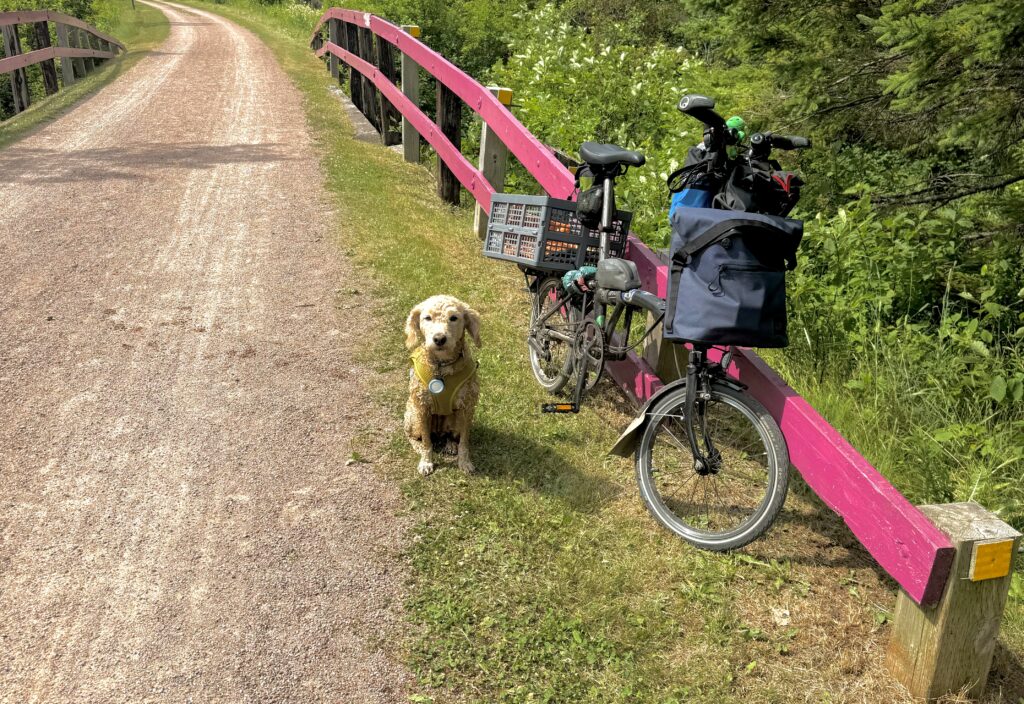
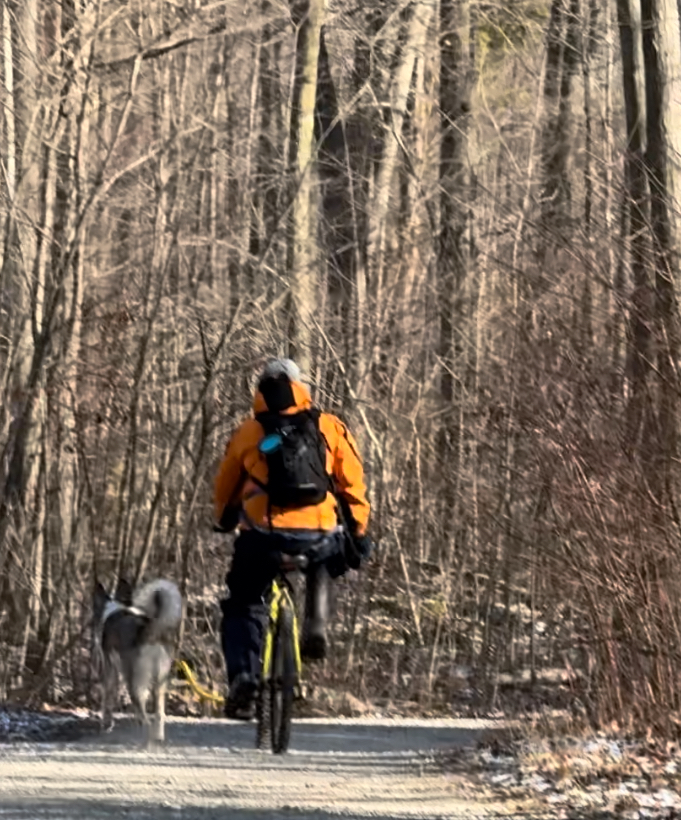
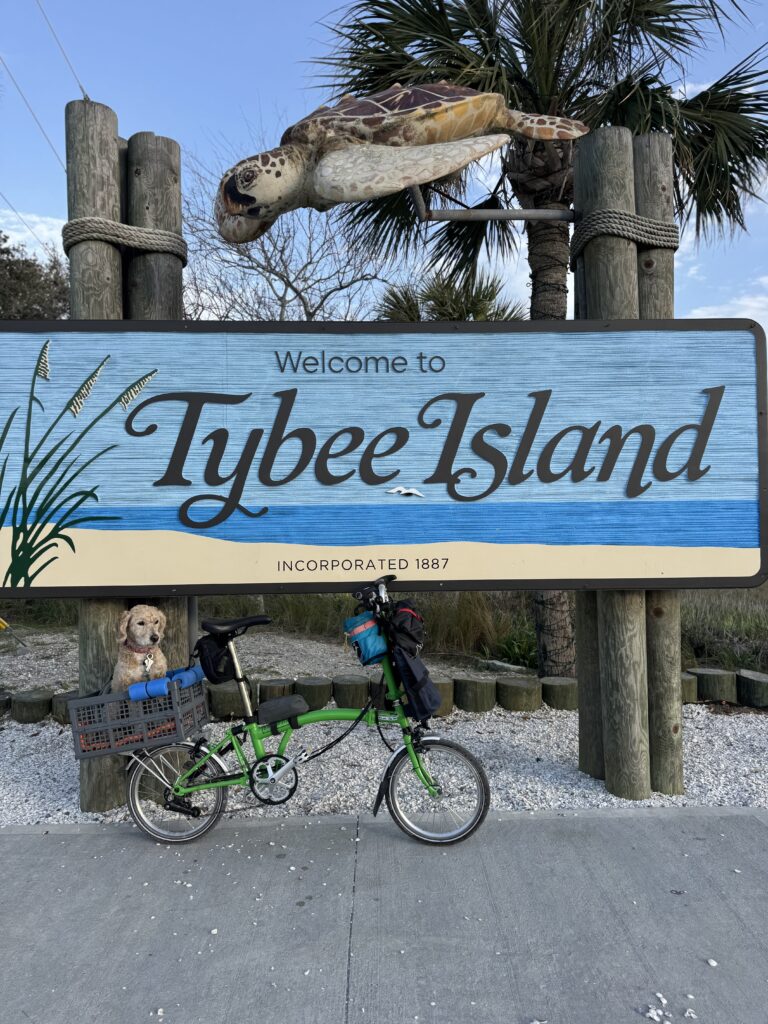
Signs Your Dog’s Having a Good Time (and When They’re Not)
Dogs speak with their bodies. A relaxed tail, rhythmic trot, forward ears, and soft eyes say: “I’m doing okay.” Stiffness, lagging, leaning to one side, or repeated shifting in the trailer? That’s feedback.
Watch for:
- Reluctance to get going or to get in the basket or trailer
- Stiffness or limping
- Changes in mood—withdrawn or unusually quiet
- Panting heavily or seeking shade
- Wounds or redness on footpads, nails, or chaffing from harnesses or clothing
The presence of any of the above if often caused by one or more of the following:
- You’re overdoing the mileage or intensity, or including too few breaks or recovery days
- Terrain conditions are beyond your dog’s tolerance (ground is too concussive or too abrasive; or the ground or air is too hot or too cold)
- They’re not consuming enough calories
- They aren’t conditioned enough
- They aren’t staying cool enough
- An illness is present
Seek veterinary attention if you have concerns about your dog while dogpacking.
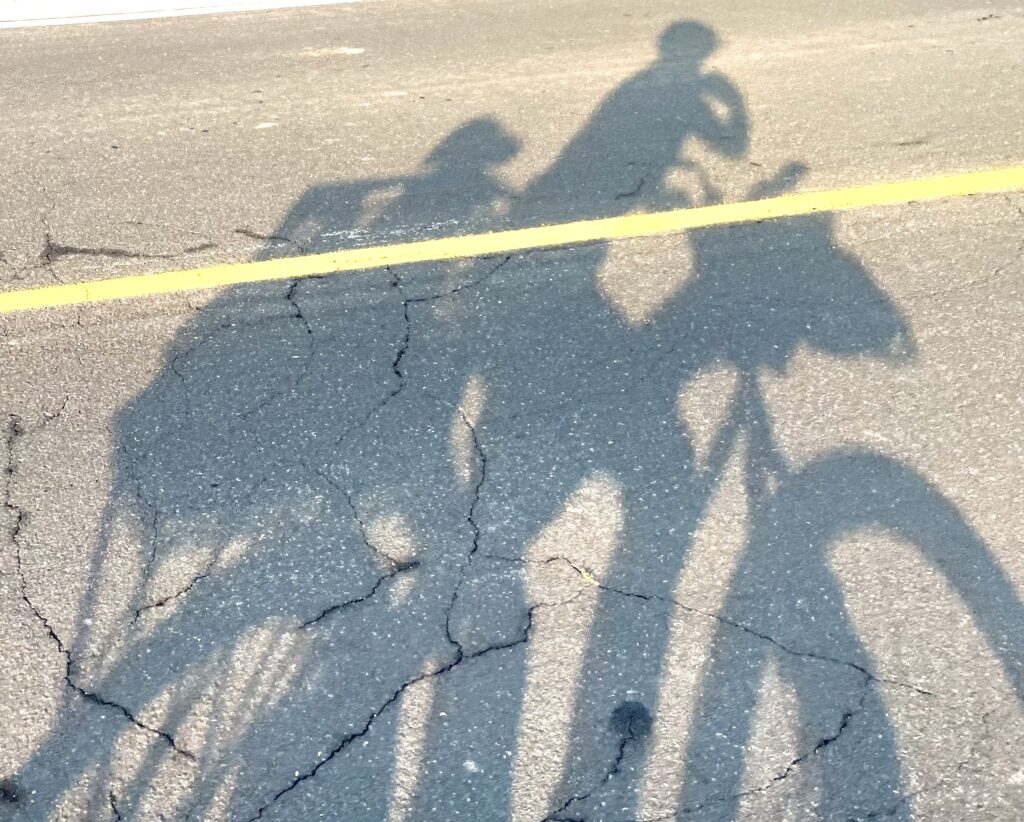
Bikepacking with your dog is about the shared experience, so enjoy let your dog “ride their ride—let them rest, let them sniff, let them enjoy it. And have fun in the togetherness that brings. Soon enough you’ll both be saying, “When we get our next bike…”
Related links
Bike Basket Training – article
5 Pillars of Canine Fitness – article
Signs of Heat Stroke in Dogs – article
How Much Can You Exercise Your Dog? – article
About the author
Krista Halling is a veterinarian board-certified with the American College of Veterinary Surgeons and creator of Dogpacking.com. She is also certified in the Human-Animal Bond and in Canine Physical Rehabilitation. Krista loves travelling and adventuring with River, her mini goldendoodle sidekick.
River Matilda Halling is a female-spayed mini goldendoodle and Chief Canine Officer of Dogpacking.com. She grew up in Ontario, Canada and loves travelling and adventuring with her mum.




Leave a Reply